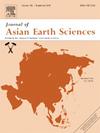根据新构造证据和地震活动推断,伊拉克东部和伊朗西部的哈纳沁断裂带的活动
IF 2.7
3区 地球科学
Q2 GEOSCIENCES, MULTIDISCIPLINARY
引用次数: 0
摘要
哈那沁断裂是一条北南向伸展的逆冲断裂,倾角偏浅,向东北方向伸展,长度约125 km。虽然该断层大部分位于伊朗西部,但它仍然被称为哈纳沁断层,指的是伊拉克东部的哈纳沁镇。在伊拉克,Gercus组的红色碎屑岩被推覆在Avanah和Pila Spi组的碳酸盐岩上。始新统碳酸盐岩逆冲覆渐新统碳酸盐岩,渐新统碳酸盐岩逆冲覆印那那组碎屑岩;沿着伊朗边境形成了一个复杂的断层岩。第二种情况下,碳酸盐岩逆冲时断平面不太清晰,而在第一种和第三种情况下,由于变形较多,断平面非常清晰,特别是在粘土岩中。2017年11月12日,伊拉克和伊朗边境地区发生7.3级地震,震源深度19公里。这次地震的震中位于苏莱曼尼亚市东南86公里,哈纳沁镇东北81公里处。我们利用卫星图像和不同比例尺的地质图来识别断层的延伸和位置。我们还发现了该地区构造活动的许多新构造迹象。此外,一个多世纪以来记录的地震活动与这项研究的结论一致。本文章由计算机程序翻译,如有差异,请以英文原文为准。
The activity of the Khanaqin Fault, east of Iraq and west of Iran, as deduced from Neotectonic evidence and seismicity
The Khanaqin Fault is an N-S extending thrust fault with a shallow dipping angle towards the northeast, with a length of about 125 km. Although the majority of the fault runs in the western side of Iran, it is still called the Khanaqin Fault referring to Khanaqin town in the eastern part of Iraq. In Iraq, the red clastic rocks of the Gercus Formation are thrusted over the carbonate rocks of the Avanah and Pila Spi formations. The Eocene carbonates are thrusted over Oligocene carbonate rocks, which in turn are thrusted over clastic rocks of the Injana Formation; forming a complex of faulted rocks along the border with Iran. The fault planes are not so clear when carbonate rocks are thrusted over carbonate rocks (the second case), whereas in the first and third cases, the fault planes are very clear with a lot of deformations, especially in claystone rocks. On 12 November 2017, an earthquake with a magnitude of 7.3 and a depth of 19 km hit the border area between Iraq and Iran. The epicenter of this earthquake is located 86 km southeast of Sulaymaniyah city and 81 km northeast of Khanaqin town. We have used satellite images and geological maps of different scales to recognize the extension and location of the fault. We also recognized many Neotectonic indications of the region’s tectonic activity. Moreover, the seismic activity recorded for more than a century aligns with the conclusions of this study.
求助全文
通过发布文献求助,成功后即可免费获取论文全文。
去求助
来源期刊

Journal of Asian Earth Sciences
地学-地球科学综合
CiteScore
5.90
自引率
10.00%
发文量
324
审稿时长
71 days
期刊介绍:
Journal of Asian Earth Sciences has an open access mirror journal Journal of Asian Earth Sciences: X, sharing the same aims and scope, editorial team, submission system and rigorous peer review.
The Journal of Asian Earth Sciences is an international interdisciplinary journal devoted to all aspects of research related to the solid Earth Sciences of Asia. The Journal publishes high quality, peer-reviewed scientific papers on the regional geology, tectonics, geochemistry and geophysics of Asia. It will be devoted primarily to research papers but short communications relating to new developments of broad interest, reviews and book reviews will also be included. Papers must have international appeal and should present work of more than local significance.
The scope includes deep processes of the Asian continent and its adjacent oceans; seismology and earthquakes; orogeny, magmatism, metamorphism and volcanism; growth, deformation and destruction of the Asian crust; crust-mantle interaction; evolution of life (early life, biostratigraphy, biogeography and mass-extinction); fluids, fluxes and reservoirs of mineral and energy resources; surface processes (weathering, erosion, transport and deposition of sediments) and resulting geomorphology; and the response of the Earth to global climate change as viewed within the Asian continent and surrounding oceans.
 求助内容:
求助内容: 应助结果提醒方式:
应助结果提醒方式:


